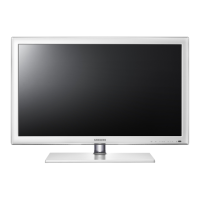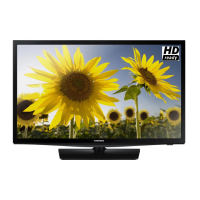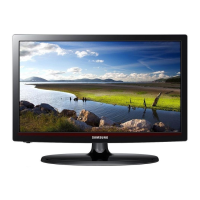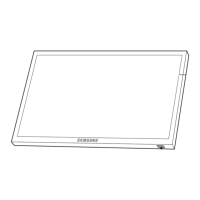S
shayesSep 12, 2025
How to fix a tilted Samsung UE19D4003BW LED TV?
- AAlbert AndersonSep 12, 2025
If your Samsung LED TV is tilted to the right or left side, remove the stand base from the TV and reassemble it.
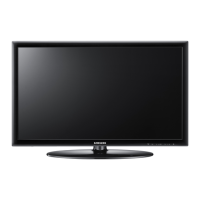
How to fix a tilted Samsung UE19D4003BW LED TV?
If your Samsung LED TV is tilted to the right or left side, remove the stand base from the TV and reassemble it.
What to do if Samsung UE19D4003BW will not turn on?
If your Samsung LED TV won't turn on, ensure the AC power cord is securely plugged into both the wall outlet and the TV. Verify that the wall outlet is working. You can also try pressing the POWER button on the TV itself to rule out a remote control issue.
Why does my Samsung UE19D4003BW keep turning off by itself?
If your Samsung LED TV turns off automatically, make sure the Sleep Timer is set to Off in the Time menu. If a PC is connected to the TV, check the PC power settings. Ensure the AC power cord is securely plugged into the wall outlet and the TV. When watching TV from an antenna or cable connection, the TV will turn off after 10 ~ 15 minutes if there is no signal.
Why is there picture but no sound on my Samsung LED TV?
If your Samsung LED TV has a picture but no sound, it might be because the TV set does not support audio if you are using a DVI to HDMI cable. Reboot the connected device by reconnecting the device’s power cable. If your TV has a headphone jack, make sure there is nothing plugged into it.
How to improve Samsung UE19D4003BW picture quality?
To improve picture quality on your Samsung LED TV: * If you have an analogue cable/set top box, upgrade to a digital set top box and use HDMI to deliver HD picture quality. * Cable/Satellite subscribers: Try HD stations from the channel line up. * Antenna connection: Try HD stations after performing Auto tuning. * Adjust the Cable/Set top box video output resolution to 1080i or 720p. * Ensure you are watching the TV at the minimum recommended distance based on the size and definition of the signal.
Why is my Samsung UE19D4003BW picture pixelated?
Picture distortion, such as pixelization on your Samsung LED TV, can be caused by compression of video content, especially in fast-moving scenes. Low signal level or bad signal quality can also cause picture distortion. Mobile phones used close to the TV (cca up to 1m) may cause noise in picture on analogue and digital TV. Note that low signal level or bad quality is not a TV issue.
Why is TV Signal Information unavailable on my Samsung LED TV?
The TV Signal Information in the Self Diagnosis Test menu is only available with digital channels from an Antenna / RF / Coax connection on your Samsung LED TV.
What to do if there are difficulties assembling the stand base of Samsung UE19D4003BW LED TV?
If you are having difficulties assembling the stand base of your Samsung LED TV, make sure the TV is placed on a flat surface. If you cannot remove the screws from the TV, please use a magnetized screw driver.
What does 'Mode Not Supported' mean on Samsung UE19D4003BW?
If a 'Mode Not Supported' message appears on your Samsung LED TV, check the supported resolution of the TV and adjust the external device’s output resolution accordingly.
How to remove the dotted line on the edge of Samsung LED TV screen?
If there is a dotted line on the edge of your Samsung LED TV screen, change the picture size from Screen Fit to 16:9. Also, try changing the cable/satellite box resolution.
| Display diagonal | 19 \ |
|---|---|
| Display resolution | 1366 x 768 pixels |
| Native refresh rate | 60 Hz |
| LED backlighting type | Edge-LED |
| Supported graphics resolutions | 1366 x 768 |
| 3D | No |
| Product color | Black |
| Tuner type | Digital |
| Analog signal format system | - |
| Digital signal format system | DVB-C, DVB-T |
| Audio system | Dolby Digital Plus, Dolby Pulse |
| RMS rated power | 6 W |
| Number of speakers | 2 |
| USB 2.0 ports quantity | 1 |
| USB 3.2 Gen 1 (3.1 Gen 1) Type-A ports quantity | 0 |
| Number of OSD languages | 29 |
| Smart modes | Game, Standard |
| AC input voltage | 220 - 240 V |
| AC input frequency | 50 - 60 Hz |
| Power consumption (max) | 35 W |
| Power consumption (standby) | 0.3 W |
| Power consumption (PowerSave) | 15 W |
| Package weight | 4100 g |
| Depth (with stand) | 124 mm |
|---|---|
| Height (with stand) | 213.4 mm |
| Weight (with stand) | 2900 g |
| Depth (without stand) | 39.9 mm |
| Width (without stand) | 447.2 mm |
| Height (without stand) | 277.8 mm |
| Weight (without stand) | 2800 g |
Automatically scans and stores available channels based on signal source.
Allows manual scanning and storage of channels for specific frequencies.
Addresses issues like poor picture, distortion, and brightness.
Solves problems related to no sound, low volume, or noise.
Troubleshoots issues where the TV will not turn on or display an image.
